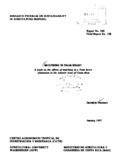Mulching in palm heart; a study on the effects of mulching in a palm heart plantation in the Atlantic Zone of Costa Rica
Description
6 fig. 3 tab. 19 ref. Sum. (En). También como: Field Report - Atlantic Zone Programme (CATIE) no. 150
Abstract
In the Atlantic Zone programme in Guápiles, Costa Rica a research is done on land use and land use planning. One of the crops of this Atlantic Zone is Palm heart (Bactris gasipaes H.B.K.). This palm tree is grown since ancient times for its fruits in Tropical America. When the palMON are young they can be harvested for the palm heart ('palmito'), which is the content of the pseudostem. Although palm heart is commercially grown for more than 20 years, it still is seen as a future crop with its expanding reputation and export market. In a palm heart plantation a mulch experiment is set up to investigate the effect of mulch on soil (micro and meso) fauna and flora leading to improved soil properties and hence crop performance. Mulching is covering the soil with some organic materials, in this case crop residues (sheets and leaves). Two fields within the plantation were selected, differing in soil type and age of establishment. In each field a 3 by 3 factorial experiment (no - normal - double mulch, and no - half of normal normal n fertilization) is laid out with four replicates per field. Daily management of the experiment started in May 1993 and continued until now. Besides normal management the crop residues have to be weighted and transported directly after harvesting and a sample of the residues has to be taken for N, P, K analyses. It was postulated that in the humid tropics under a perennial self mulching crop no effect of mulch can be expected due to better infiltration of rainwater, reduction of evaporation, reduction of soil temperature, or import of nutrients. The hypothesis is that mulching improves the soil flora and fauna leading o.a. to a better soil structure. However this effect cannot be determined directly without destroying the soil and the experiment. Effects resulting from a better structure (improved soil properties and crop performance) could be determined in soil water conditions by analyzing the soil suction on different depths and distances from the palm, palm heart production, by analyzing the harvest data and nutrient content of the harvest residues. The result showed that after one year of managing the experiment no effects can be recognized in total yield of palm heart. A relation between mulch production and nutrient uptake could not be distinguished. The mulch has some effect on the soil suction characteristics, but how much and how related is not worked out. The whole experiment considered, more time and data are needed to be able to distinguish any effects of the different mulch and N treatments.
Keywords
Publisher
Centro Agronómico Tropical de Investigación y Enseñanza (CATIE), Turrialba (Costa Rica). Atlantic Zone Programme Agricultural University Wageningen, Wageningen (Países Bajos) Ministerio de Agricultura y Ganadería, San José (Costa Rica)
URI (Permanet link to cite or share this item)
https://repositorio.catie.ac.cr/handle/11554/3192Collections
- Publicaciones y documentos [4419]


